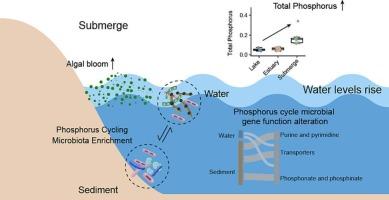青海湖淹没区磷释放与微生物群落变化
IF 7.2
1区 地球科学
Q1 GEOSCIENCES, MULTIDISCIPLINARY
引用次数: 0
摘要
在水位上升的驱动下,青海湖淹没区的形成导致了环境特征、磷动态和微生物群落组成的实质性变化。气候驱动的水文扩张促进了淹没沉积物中磷的再动员,因此需要有针对性的管理来减轻青海湖和类似的高山生态系统的富营养化风险。本研究考察了淹没对湖泊周围多个地点的水化学、沉积物性质和微生物群落的影响,包括淹没区、河口和湖体。水质分析表明,洪涝区水体富营养化和污染程度明显高于湖泊和河口区,颗粒物和叶绿素含量显著增加。pH值和氧化还原电位测量结果显示,淹没区与湖泊具有相似的特征,pH值升高,氧化还原位移明显。沉积物分析表明,沉积物的颗粒组成发生了显著变化,淹没带沉积物中大于0.63 mm的粗砂占大部分,而湖泊和河口沉积物中较细的颗粒(<0.16 mm)占主导地位,反映了洪水导致的沉积物结构变化。潜水区水体磷浓度显著升高,总磷和无机磷含量均高于湖泊。此外,微生物多样性分析表明,淹没区微生物群落表现出与湖泊和河口不同的特征,其共生网络和优势微生物类群的变化更为复杂,以红杆菌科和假单胞菌科为主。与磷相关的基因丰度,特别是与磷代谢有关的基因丰度,在淹没区域更高,表明微生物对磷循环的贡献增强。这些发现表明,新淹没区不仅加速了内部磷负荷,而且重构了微生物网络,从而增加了富营养化的风险。它强调了可能影响水生生态系统整体健康和稳定的营养循环和微生物动力学的变化。本文章由计算机程序翻译,如有差异,请以英文原文为准。

Phosphorus release and microbial community alterations in submerged areas of Qinghai Lake
The formation of submerged areas in Qinghai Lake, driven by rising water levels, has resulted in substantial changes in environmental characteristics, phosphorus dynamics, and microbial community composition. Climate-driven hydrological expansion promotes phosphorus remobilization in submerged sediments, necessitating targeted management to mitigate eutrophication risks in Qinghai Lake and analogous alpine ecosystems. This study examines the impacts of submersion on water chemistry, sediment properties, and microbial communities across multiple sites around the lake, including submerged regions, estuaries, and the lake body. Water quality analysis revealed that eutrophication and pollution were more pronounced in flooded areas compared to the lake and estuarine zones, with particulate matter and chlorophyll significantly increased. pH and redox potential measurements revealed that submerged areas exhibited similar characteristics to the lake, with elevated pH and distinct redox shifts. Sediment analysis demonstrated significant changes in particle composition, with coarse sands larger than 0.63 mm accounting for most of the sediment in submerged zones, whereas finer particles (<0.16 mm) predominated in the lake and estuarine sediments, reflecting alterations in sediment texture due to flooding. Phosphorus concentration in water bodies was significantly elevated in submerged areas, with higher levels of both total phosphorus and inorganic phosphorus forms compared to the lake. Moreover, microbial diversity analysis indicated that microbial communities in submerged areas exhibited distinct characteristics from those in the lake and estuary, with greater complexity in co-occurrence networks and shifts in dominant microbial taxa, notably Rhodobacteraceae and Pseudomonadaceae. The abundance of phosphorus-related genes, particularly those involved in phosphate metabolism, was higher in submerged areas, indicating an enhanced microbial contribution to phosphorus cycling. These findings suggest that newly submerged zones not only accelerate internal phosphorus loading but also restructure microbial networks, thereby enhancing the risk of eutrophication. It emphasized shifts in nutrient cycling and microbial dynamics that may affect the overall health and stability of the aquatic ecosystem.
求助全文
通过发布文献求助,成功后即可免费获取论文全文。
去求助
来源期刊

Gondwana Research
地学-地球科学综合
CiteScore
12.90
自引率
6.60%
发文量
298
审稿时长
65 days
期刊介绍:
Gondwana Research (GR) is an International Journal aimed to promote high quality research publications on all topics related to solid Earth, particularly with reference to the origin and evolution of continents, continental assemblies and their resources. GR is an "all earth science" journal with no restrictions on geological time, terrane or theme and covers a wide spectrum of topics in geosciences such as geology, geomorphology, palaeontology, structure, petrology, geochemistry, stable isotopes, geochronology, economic geology, exploration geology, engineering geology, geophysics, and environmental geology among other themes, and provides an appropriate forum to integrate studies from different disciplines and different terrains. In addition to regular articles and thematic issues, the journal invites high profile state-of-the-art reviews on thrust area topics for its column, ''GR FOCUS''. Focus articles include short biographies and photographs of the authors. Short articles (within ten printed pages) for rapid publication reporting important discoveries or innovative models of global interest will be considered under the category ''GR LETTERS''.
 求助内容:
求助内容: 应助结果提醒方式:
应助结果提醒方式:


